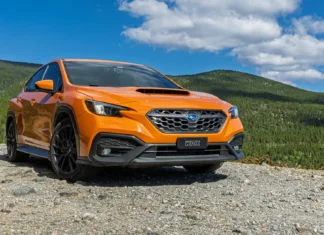Fellow automotive YouTuber SavageGeese recently put out a video going over the worst trends in modern vehicles. In that video, he covered some of the most annoying features that many manufacturers are building into their new cars.
While some automotive trends are frustrating to live with, there are others that we should be really happy about. So, in response to the worst car trends, this video is going to cover the top 10 best trends in modern cars. We’re going to count down 10 features and technologies that make the cars we drive today better than anything we’ve seen before. If an automotive trend you like isn’t mentioned here, please drop a comment down below.

10. Driver Assistance Technology
Here, I’m referring to any technology in a new car to make the driving experience safer, more comfortable and more convenient. This includes features like adaptive cruise control, lane keep assist, automatic emergency braking, heads-up displays, 360-degree cameras, automatic high-beams and more.
The one feature we like most is the heads-up display. This technology is really catching on in newer cars, and they can be used to display all sorts of information, including your speed, what gear you’re in, navigation instructions and what music you’re playing. They’re really cool because they allow drivers to keep their eyes on the road, since most of the information you need is right in your line of sight.
These driver assistance technologies are becoming standard equipment on many new models. Toyota Safety Sense 2.0, for example, is a driver enhancement suite that includes adaptive cruise control, automatic emergency braking with pedestrian detection, blind spot monitoring, lane keep assist and adaptive high beams. The Safety Sense 2.0 suite is standard equipment on the new Corolla as well as the new RAV4. Other manufacturers are fitting this sort of driver assistance tech as standard equipment across their lineups as well.

9. Have it your way
In a lot of ways, we have so much more choice than we’ve ever had before. Three specific features that highlight this particularly well are adaptive suspension, customizable exhaust notes and power-adjustable seats. This trend of customization is even making its way down to entry-level economy cars, and is no longer reserved for high-end luxury or performance models.
Adaptive suspension allows drivers to adjust the firmness of the car’s ride at the push of a button. That lets you have a soft, comfortable ride for your morning commute. Then, when the road gets twisty, you can firm up the suspension to improve the car’s handling.
Then there’s changing up your exhaust noise. More modern cars feature butterfly valves in the exhaust system that open or close depending on how loud you want the exhaust to be. Opening the valve results in more noise, while closing it keeps the car quiet. Cars like the Ford Mustang let you choose an exhaust mode so you can thunder down the open road, or keep from annoying everyone in your neighborhood.

This level of customization is a trend we love. Let’s face it – we can’t all afford a different car for every occasion. Many of us need one vehicle that can do many things. Being able to change up the ride, noise and seating position in more and more ways makes a car usable in a wider variety of situations. The Hyundai Veloster N has both adaptive suspension and adaptive exhaust. You can have a loud, crackling track monster with one setting, and a comfy, quiet hatchback with another.

8. Combustion engine 2.0
What do I mean by combustion engine 2.0? While electrification may be on the horizon, manufacturers are refining the combustion engine here and now, to make it both more powerful and more efficient. Nissan now has a turbocharged variable compression ratio engine that can adapt to the driving situation for more power or more efficiency.
Mazda will also soon sell their new SkyActiv-X engine that, simply put, combines the benefits of gasoline and diesel power. By incorporating elements from both engines into a single unit, the SkyActiv-X engine can produce more power while also using less fuel than previous gasoline engines.
Even the Swedish hypercar manufacturer Koeniggsegg has gotten in on the party. They are developing a technology called “FreeValve”, that features fully variable valve actuation. What that means is instead of tying valves together using camshafts, future engines may use pneumatic springs tied to position sensors to precisely control when and how much each individual valve opens and closes. Being able to do that allows for great control over the combustion cycle, allowing for more power and greater efficiency.
7. AWD for the masses
All-wheel drive is more popular than ever before, particularly with booming crossover sales, and that is a really cool thing for us consumers. All-wheel drive systems used to be more of a luxury – an option that would cost thousands of dollars and was only offered on larger, more expensive vehicles. But now that technology is getting cheaper, and easier to use on smaller, less expensive cars.
For example, Subaru – a company that helped push all-wheel drive to the people – offers their Impreza for $18,495 with AWD. The Jeep Renegade comes with AWD for just over $20,000, as does the Hyundai Kona.
For those of us who live in a place with harsh winters, all-wheel drive coupled with good snow-ready tires offers great piece of mind. Even in warmer areas, all-wheel drive cars can offer more sure-footed handling on twisty roads, making for a safer and, in some ways, more fun driving experience.
 6. Autonomy
6. Autonomy
This will be a controversial item for driving enthusiasts out there, but hear me out. Each year, we are getting closer to having passenger cars that can drive themselves. Cadillac’s Super Cruise and Tesla’s autopilot are two examples of autonomous tech that already exist. Plus, more are on the way from virtually every other manufacturer. Eventually, these systems will become so advanced, they’ll be able to help alleviate traffic and reduce accidents, which would mean less headache for everyone.
The enthusiast in me is definitely scared about losing the ability to drive. But, on the other side of the token, there are advantages to autonomous vehicles. My parents are not at an age where I need to worry about their mobility, but some of you might have friends or family who may not be in the best state to drive as well as they used to.
It’s nice to know that they’ll be able to hop in an autonomous vehicle to take them around. They get to keep their independence, while the car will get them to their destination safely. For the rest of us, it would take some of the headache out of driving through traffic. Simply being able to tell your car where to go, while it takes care of all the driving, would make some situations a lot less stressful.
 5. Headlights
5. Headlights
The Insurance Institute for Highway Safety says about half of all fatal crashes in the U.S. occur after dark. What’s even worse is that more than a quarter of fatal accidents occur on unlit roads. That’s why good headlights are super important, and luckily for us, the technology is getting much better in modern vehicles.
Laser and LED matrix headlights are two great examples of how much headlight technology has advanced in recent years. Audi’s Matrix LEDs use a series of 25 LED bulbs which can actively block out a portion of the beam. This allows the headlight to avoid blinding oncoming drivers. The system judges when to dim part of the beam depending on what radar and camera systems detect up ahead. That way, it can dim the bulbs that shine directly into the oncoming lane, while still illuminating the road ahead of you.
Laser headlights offer a brighter beam that uses less energy. BMW says their laser headlights are 1,000 times brighter than LEDs, but use half the energy, meaning less energy taken away from other electrical systems. Plus, the laser headlight assembly is much smaller than traditional headlights. This gives designers more freedom to design sleeker, more aerodynamic cars without having to build in big, bulbous and inefficient light assemblies.
These days, the IIHS is testing headlight performance as a part of its safety rating program. This means manufacturers will have to keep improving headlight tech, which will result in better, safer headlights for all of us.
 4. Transmissions
4. Transmissions
In the past few years, we have seen transmissions gain more and more gears. 8, 9, and 10-speed transmissions are a common occurrence in new cars, and that’s a good thing. Having more speeds in a transmission allows a car to better select the right gear for the situation. That lets the engine run more efficiently. While more gears allows for better use of the engines power, automatic transmissions have gotten faster and more robust than before, which is one reason they’ve been replacing the old-fashioned manual transmission in most modern cars.
Manual transmissions aren’t as prevalent as they used to be. But, they’ve also improved by way of electronic rev-matching systems that make it easier to downshift. Continuously Variable Transmissions have also improved in recent years. They’re not the most engaging transmissions in the world. However, they offer relatively smooth power delivery and comparable efficiency to modern automatics.
 3. Apple CarPlay, Android Auto, Amazon Alexa
3. Apple CarPlay, Android Auto, Amazon Alexa
Modern infotainment systems have made their way down to even the most basic new cars, and they allow us a way to plug our phones in so we’re always connected to the world. Our messages, phone calls, music, and navigation can now all be accessed through the screen on our dashboard. This helps especially in cars without their own navigation systems. Apple CarPlay and Android Auto offer a new degree of connectivity through your smartphone for free.
Amazon Alexa is also becoming more prevalent in modern cars, letting drivers use voice commands to control not just functions inside the car, but their other internet-connected devices as well, like smart devices inside the home. Having all this connectivity in one location means that, ideally, people spend less time looking at their cellphones and more time focusing on the road.
Savage Geese made a great point in his video. The lack of standardization in infotainment systems makes them really frustrating to use. More manufacturers are integrating Android Auto and apple CarPlay. So, you have a system that are familiar regardless of what car you’re in. What’s more, they’re well thought out, intuitive and responsive, so they’re easier to learn right off the bat. This sort of support has become so commonplace in new cars that we actually find it disappointing when a car doesn’t have it.
 2. Lightweight Materials
2. Lightweight Materials
Cars are getting bigger than before, yet they’re also getting lighter. That’s mainly thanks to the increased use of lightweight materials. Carbon fiber, composites, aluminum and other alloys are increasingly being used in the construction of our cars over traditional steel body work. Automakers also use special adhesives in certain areas over using bolts and rivets. All of those small changes add up to make modern cars lighter than ever before. Especially considering how much technology we’re cramming into them.
Less weight is good for a number of different reasons. You get better fuel economy, better acceleration, better handling, and better braking performance. Plus, it allows manufacturers to add in all of the great technology that we talked about earlier. Making cars lighter while also improving safety will always be a good thing in my book.

1. More Reliable than Ever
Take a look at long-term dependability ratings from firms like JD Power or Consumer Reports. You’ll find that new cars are more satisfying to own today than ever before. New cars are getting more and more reliable than ever before. Manufacturers have incorporated more computers into modern cars. This allows mechanics to diagnose problems through the OBD II port. Even so, those problems are fewer and farther between as manufacturers have improved build quality in their newer models.
Plus, they’re also offering longer comprehensive warranties on their new cars. Hyundai and Kia famously offer a 10-year/100,000 mile warranty. Volkswagen also now has a 6-year/72,000 mile warranty on their new vehicles. That means more piece of mind for buyers who put down thousands of dollars toward buying brand new cars. It’s good to know that those cars likely won’t end up back in the shop all the time.
























